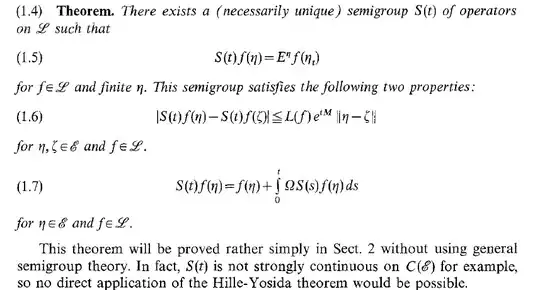In the article of Liggett and Spitzer "Ergodic Theorems for coupled Random Walks and Other Systems with Locally Interacting Components" 1981 Z. Wahrscheinlichkeitstheorie in page 445 one reads:
I don't see why $S(t)$ is not a strongly continuous operator,
A strongly continuous semigroup in $C(\mathcal{E})$ is such that for every $t_n \to 0$ $||S(t_n)f - f|| \to 0$. for every $f \in C(\mathcal{E})$. Here the norm is the sup norm $||f|| = \sup_{x \in \mathcal{E}} |f(x)|$
To see that it is not strongly continuous, one needs to find an $\epsilon>0$, a function $f \in C(\mathcal{E})$ and a sequence $t_n \to 0$ such that $$||S(t_n)f - f|| > \epsilon $$
In our context, the semigroup is defined for function in $\mathcal{L}$ the space of Lipschitz continuous functions on $\mathcal{E}$
Even though the space $C(\mathcal{E})$ has not been defined, one can reasonably consider it the space of continuous functions. Therefore $C(\mathcal{E}) \supset \mathcal{L}$.
The question therefore is: can we find $\epsilon>0$, a function $f \in C(\mathcal{E})$ and a sequence $t_n \to 0$ such that $$||S(t_n)f - f|| > \epsilon $$
Moreover, can this $f$ be such that $f \in \mathcal{L}$?

